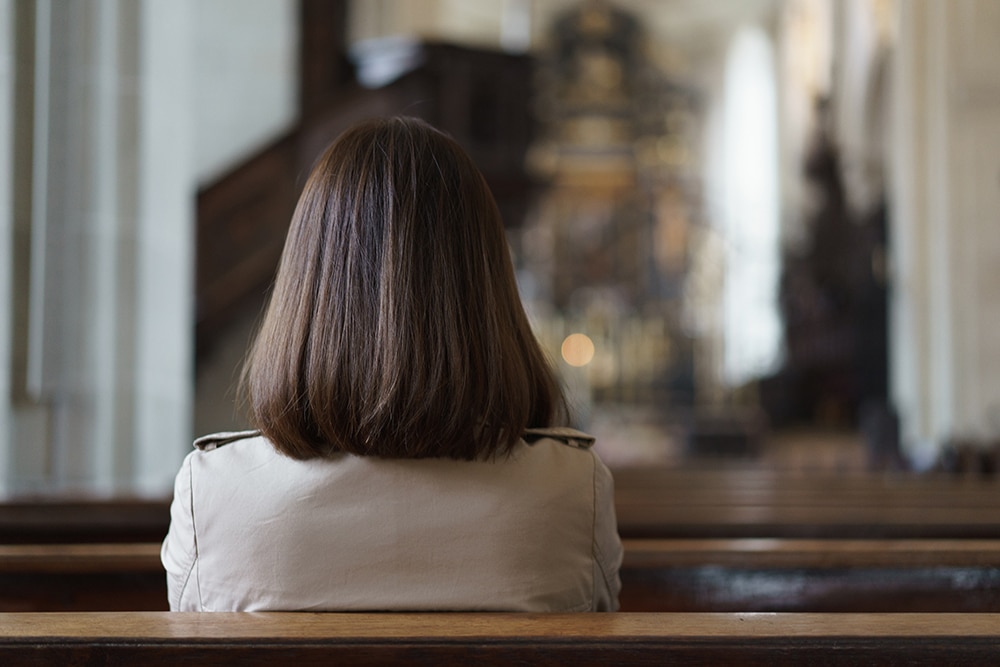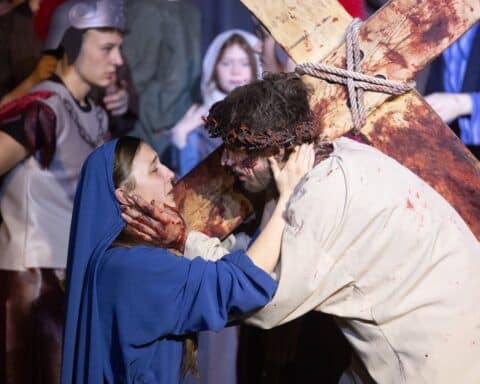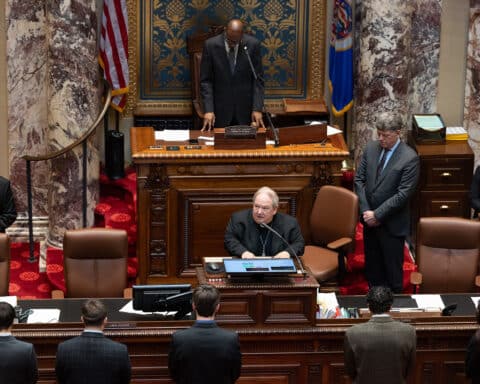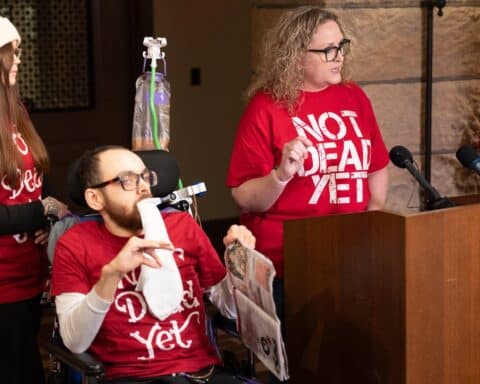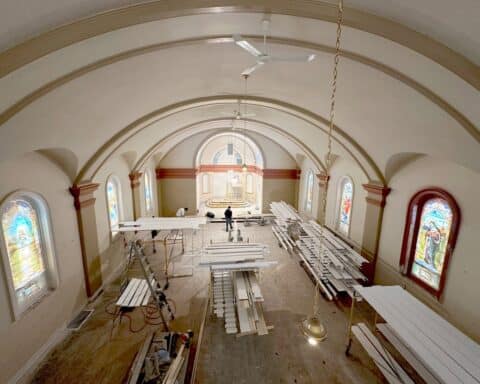ST. PAUL, Minn. (CNS) — Limiting the congregation to 10 people per Mass, sanitizing hands and encouraging face masks were steps a parish in North St. Paul made to start public Masses the week of May 18.
“I think it was a real yearning for our priests here. Our parishioners were yearning for it as well,” said Jeff Peterson, chief of staff at St. Peter Parish, which is served by the Priestly Fraternity of St. Charles Borromeo.
Initially anticipating that at least a third of the church could be used — allowing more people per Mass — St. Peter and many other parishes across the Archdiocese of St. Paul and Minneapolis geared up for the first public Masses since mid-March.
But Gov. Tim Walz’s much-anticipated May 18 loosening of some COVID-19 safety directives continued to limit religious gatherings to 10 or fewer people.
That prompted some parishes, such as Pax Christi in Eden Prairie, to start planning for 10-person public Masses beginning May 26, while other parishes wait in hopes of a more promising start after Archbishop Bernard A. Hebda of St. Paul and Minneapolis and the state’s other Catholic bishops discussed that directive with Walz’s administration May 18 and 19.
On May 15, the archbishop expressed disappointment with the 10-person limit Walz announced May 13 when unveiling the next phase of the state’s COVID-19 response, Stay Safe Minnesota. The governor’s stay-at-home order expired May 18.
In anticipation of that order’s expiration, Minnesota’s Catholic bishops asked parishes May 1 to prepare to resume public Masses by May 18 at one-third church capacity. The governor’s most recent executive order has prompted the bishops to reconsider the date for opening. Archbishop Hebda said in a May 15 statement that the bishops would announce their next steps toward public Masses following their meetings with Walz’s administration.
Father John Ubel, rector of the Cathedral of St. Paul in St. Paul, expressed his disappointment in Walz’s directive in a May 14 letter to the editor of the Minneapolis Star Tribune. He was among priests ready to begin offering public Masses at 30% capacity May 24.
Considering the cathedral’s size, “a limit of 10 people appears unscientific, unjustified and, dare I say, capricious. What a shame,” Father Ubel said in his letter.
He told The Catholic Spirit, the archdiocesan newspaper, that if the governor changed his directive before May 24, the parish would do all it could to offer public Masses, but so much would depend on the timing and details of such an announcement. But by May 31, the cathedral could be ready to accommodate any new directives that would expand current capacity limitations, he said.
Father Ubel said he wrote the letter to the editor because “having a voice in the public square is critically important. The faithful have legitimate questions. To many of them, it appeared that our sincere efforts to be responsible in our planning were met with a lack of flexibility and a ‘one-size-fits-all’ for spaces of varying sizes.”
Parish officials at St. Peter pressed on despite the 10-person limit, offering weekday Masses beginning May 19 for congregations of up to nine people at 6:30 a.m., 8 a.m., 9:30 a.m. and 5 p.m. Parishioners could sign up for a Mass at the parish’s website.
Meanwhile, St. Peter plans to continue to livestream its 10:30 a.m. Sunday Masses for those who cannot attend Mass in person, Peterson said. “We’re balancing the need to fulfill the spiritual side, while at the same time balancing the safety side,” he said.
The archdiocese’s Office of Worship released directives May 8 recommending that people older than 65 or with underlying health conditions not yet attend in-person Mass. Archbishop Hebda has reiterated that archdiocesan-wide dispensation from the obligation to attend Sunday Mass and holy days of obligation continues until all people can safely attend Mass again.
At St. Peter, a priest along with another member of the clergy would celebrate each Mass; or the priest with an altar server; or a musician, cantor or lector, Peterson said. Signs outside and throughout the church instruct people where to stand, point to a hand-sanitizing station and provide other instructions, while ushers help people navigate the process. People are assigned seats at least 6 feet part.
Those arrangements were to continue through the weekend Masses, at which point they might be changed to accommodate more people, if that became a possibility, the church said on its website.
The church at St. Peter was thoroughly cleaned after the coronavirus hit Minnesota, and it continues to be cleaned as people participate in eucharistic adoration and confession from 2 p.m. to 4 p.m. Tuesdays, Thursdays and Saturdays, Peterson said.
Diluted bleach was replaced with another, noncaustic cleansing procedure because the finish on the pews was wearing away, he said.
The $2,000 permanent, spray-cleaning unit with a replaceable, $400 cartridge cleans the church in an environmentally friendly manner, Peterson said. Plans are to purchase a similar unit for the school, and share information about the product with other parishes, he said.
At the cathedral, plans for allowing one-third of its capacity to be used for public Masses include roping off two out of every three pews with newly purchased cords, proper cleaning of the church and a detailed seating chart shown on large maps placed at all entrances, Father Ubel said.
In southern Dakota County, the three rural parishes of St. John the Baptist in Vermillion, St. Mathias in Hampton and St. Mary in New Trier have been preparing to reopen, but with the governor’s limitations on faith-based gatherings, plans are on hold, said their shared parochial administrator, Father Michael Tix.
In the meantime, their leaders are focusing on developing volunteer cleaning teams to disinfect pews and other “touch points” before and after Masses when their churches do reopen.
Father Tix, who also serves as the archdiocese’s episcopal vicar for Clergy and Parish Services, has been using the May 8 document from the archdiocese’s Office of Worship, as well as the resources from state officials, to inform his parishes’ plan for reopening safely. He suggests that around the archdiocese, it may take a group of people at each parish to evaluate their particular situation and determine what could work best.
“Every church, every church building is a little different from one other,” he said. “Some churches are built in 1900, and there’s a long, narrow (nave) … and then you’ve got the cathedral, and then you’ve got … a church in the round. How do you apply (regulations and recommendations) to different places?”
And, like pastors around the archdiocese, he doesn’t know whether Catholics will rush back to Mass, or be cautious about — or even uncomfortable with — returning as long as the pandemic persists.
“It’s going to be a new normal,” Father Tix said.

